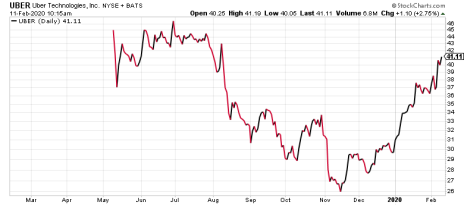Slack and Uber Stock Were Last Year’s Most-Hyped IPOs. Not Surprisingly, Both Soon Came Crashing Back to Earth. Is Either Worth a Long-Term Investment Now?
We’ve written ad nauseam here about the inherent risks of investing in IPOs (initial public offerings) when they first come public. Too many of them have a big run-up in their first day of trading, only to come crashing back to earth in the ensuing weeks and often months, until lockup agreements expire. And the more hyped the IPO prior to its market debut, the more likely it is to crater after the initial flurry of excitement subsides. For evidence, look no further than Slack and Uber stock last year.
They were the two highest-profile IPOs of 2019, and both cracked the top 10 all-time in terms of deal size, raising a combined $15.4 billion in their initial offerings. Wall Street was positively giddy about both when they came public in successive months in the first half of last year.
You’re probably familiar with Uber (UBER). It’s the ride-sharing application that, along with Lyft (LYFT), has supplanted the taxi cab as the preferred method of rides for hire. The company has done $14.2 billion in sales over the last 12 months, and grew revenues by 37% last quarter.
And yet, here’s what a chart of Uber stock looks like since its May 2019 IPO:
Things have been much better for UBER lately, after the stock bottomed at 26 in November. But that doesn’t undo the near-50% bath it took in the months after its initial offering.
Slack (WORK) has fared even worse since its June 2019 IPO. Some of you are probably familiar with Slack; it’s a cloud-based instant messaging platform used primarily in the workplace. We at Cabot use it; most of our workday communication is done over Slack. It’s a great, efficient program. And the company is growing – it’s done $570 million in sales over the last 12 months, and revenue grew roughly 60% in the last quarter.
But so far, the stock stinks. WORK is down 30% in the eight months since its IPO, and has been trapped in a range between 20 and 26 since last September. It currently trades near the top of that range, but we’d need to see more upward momentum to conclude big investors are buying in.
Slack vs. Uber Stock: Which Bounce-back Candidate to Buy
Neither Slack nor Uber makes money yet, though both companies’ losses are narrowing. Slack is expected to grow its top line faster this year, at +55%, compared to +29% for Uber. But it’s really an apples-to-oranges comparison. Uber is expected to bring in north of $18 billion in sales in 2020; Slack will be in the $600 million range.
Because of that discrepancy, there’s a wide chasm between the two stocks’ values. WORK has a price-to-sales ratio of 24.7; Uber stock trades at just five times sales (neither stock has a price-to-earnings ratio, since they have no earnings yet). Given that disparity, and the clear momentum in UBER’s chart over the last three months, it’s the easy choice when comparing Slack vs. Uber stock.
Slack stock is at least trading back above its 50-day moving average. But until it breaks out of its six-month range, it’s not worth the investment. Uber stock, on the other hand, looks quite tempting. In fact, Mike Cintolo, chief analyst of our Cabot Growth Investor advisory, just added UBER to his watch list.
Here’s a snippet of what he wrote about the stock this week:
“The stock has come to life in a persistent way—UBER bottomed in November and has shown excellent strength this year, including last week’s big-volume move on earnings. There’s a bit of old, post-IPO overhead to chew through, but it certainly appears that perception has turned the corner, with big investors focusing on big profits down the road.”
Like most overhyped IPOs, UBER had to eat some humble pie for a good six months. Now the stock is in full recovery mode, and it has some very encouraging fundamentals to extend well into the coming weeks and months. Many high-profile IPOs do the aforementioned tailspin but then, months later, emerge—and it looks like UBER may be following that very path.
[author_ad]



